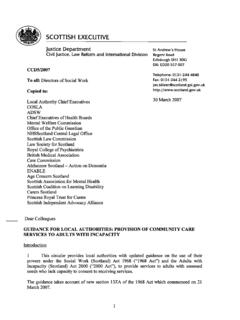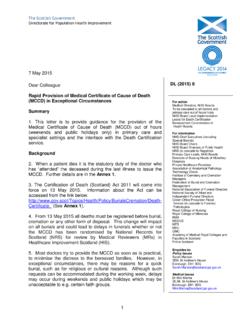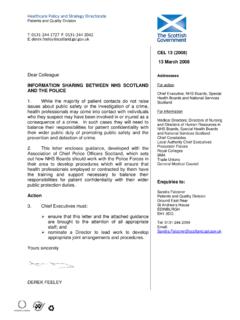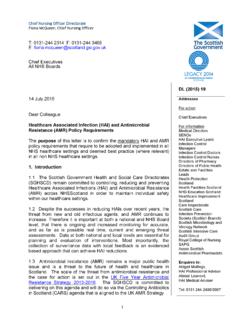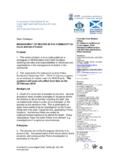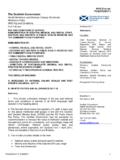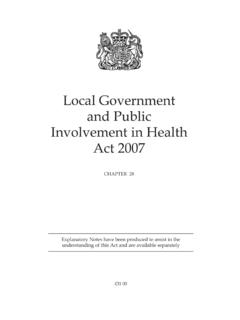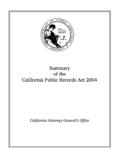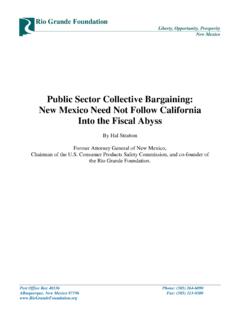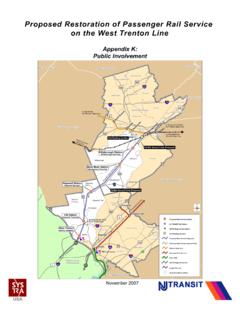Transcription of CEL 4 (2010) - Informing, engaging and consulting …
1 Director-General health and Chief Executive NHS Scotland Dr Kevin Woods T: 0131-244 2410 F: 0131-244 2162 E: abcdefghijklmnopqrstu CEL 4 (2010) 10 February 2010 Dear Colleague informing , engaging AND consulting people IN developing health AND COMMUNITY CARE SERVICES Purpose To provide revised guidance informing , engaging and consulting people in developing health and Community Care Services to assist NHS Boards with their engagement with patients, the public, and stakeholders on the delivery of local healthcare services. The principles of the guidance should be applied, proportionally, to any service change proposed by a Board, including any changes considered to be major. Summary The guidance, which has been prepared by the Scottish Government health Directorate in consultation with a wide range of stakeholders, supersedes the Scottish Home and health Department circular ( Closure and Change of Use of health Service Premises ) dated 3 June 1975, the draft interim guidance ( Consultation and Public Involvement in Service Change ) issued through an HDL in 2002 (HDL (2002) 42), and the draft guidance ( informing , engaging and consulting the Public in developing health and Community Care Policies and Services ) issued for comment in 2004.
2 Scope The guidance: Sets out the relevant legislative and policy frameworks for involving the public in the delivery of services; Provides a step-by-step guide through the process of informing , engaging and consulting the public in service change proposals; Explains the decision making process with regard to major service change and the potential for independent scrutiny; and Clarifies the role of the Scottish health Council. Addresses For action NHS Board Chief Executives; NHS Board Directors of Planning; NHS Patient Focus and Public Involvement Designated Directors For information NHS Board Directors of Human Resources; Chairman, Scottish health Council Director, Scottish health Council; SWAG; MSG; SPF Enquiries to: John B Davidson Public Involvement Manager St Andrew s House Regent Road Edinburgh EH1 3DG Tel: 0131-244-4152 Fax: 0131-244-2989 Or, for Scottish health Council documents, to: Sandra McDougall Head of Policy Scottish health Council National Office, Delta House 50 West Nile Street Glasgow, G1 2NP Tel: 0141 225 5560 @scottishh St Andrew s House, Regent Road, Edinburgh EH1 3DG abcde abc a How to use the Guidance Whilst decisions regarding the provision of NHS services remain a matter for NHS Boards (with the exception of major service changes), there is a need to ensure a consistent and robust approach is adopted when Boards consider and propose new services or changes to existing services.
3 This guidance should therefore provide a suitable framework to deliver that aim. The guidance should also be considered alongside associated guidance prepared by the Scottish health Council on major service change ( Guidance on Identifying Major health Service Changes ) and the option appraisal process ( Involving Patients, Carers and the Public in Option Appraisal for Major health Services Changes ). Training As part of their commitment to the provision of training in support of NHS Boards Patient Focus and Public Involvement activity, NHS Education for Scotland has commissioned training for NHS staff which will assist in the implementation of this guidance. For further information please contact Jane Davies, Educational Projects Manager (PFPI) at NES on 0141 352 2927 or Access and Updating The guidance will be available in electronic format on the Scottish Government website and the Scottish health Council s website (where the guidance on major service change and the option appraisal process can also be found).
4 The guidance will be reviewed by the end of 2011, or earlier if required. Actions for NHS Boards NHS Boards are asked to ensure that this guidance is brought to the attention of all appropriate staff involved in the provision of new services or changes to existing services. Ministers will wish to see evidence of this when considering proposals for major service change and through Boards wider patient focus and public involvement activities. Yours sincerely KEVIN WOODS St Andrew s House, Regent Road, Edinburgh EH1 3DG abcde abc a Issued through CEL 4(2010) informing , engaging AND consulting people IN developing health AND COMMUNITY CARE SERVICES Introduction 1. This guidance has been developed to assist NHS Boards with their engagement with patients, the public and stakeholders on the delivery of local healthcare services.
5 The principles of the guidance should be applied, proportionally, to any service change proposed by a Board, including any changes considered to be major . When appropriate, Special Boards and the Common Service Agency/NSS Scotland1 exercising a non-clinical or public-facing function should also follow the principles of this guidance when engaging with their stakeholders. 2. The duty of public involvement covers all health Boards, Special health Boards and the Common Services Agency when they are providing a service to the public which they are responsible for2. This also includes when services are provided on their behalf, for example by a contractor, to the public. For health Boards this will cover the majority of their actions but Special health Boards and the CSA will have to consider whether their actions impact directly on services provided to individuals and, if so, follow the principles of this guidance.
6 3. This guidance supersedes the Scottish Home and health Department circular ( Closure and Change of Use of health Service Premises ) dated 3 June 1975, the draft interim guidance ( Consultation and Public Involvement in Service Change ) issued through an HDL in 2002 (HDL (2002) 42), and the draft guidance ( informing , engaging and consulting the Public in developing health and Community Care Policies and Services ) issued for comment in 2004. Background 4. NHS Boards are required to involve people3 in designing, developing and delivering the health care services they provide for them. Boards responsibilities in this area were initially set out in the policy document, Patient Focus and Public Involvement (PFPI). However, to reflect the importance of this agenda, duties of public involvement and 1 References to NHS Boards or Boards should be read to include reference to Special health Boards and CSA/NSS where appropriate.
7 2 Section 2B of the National health Service (Scotland) Act 1978, as inserted by the National health Service Reform (Scotland) Act 2004. 3 in this guidance the word people should be interpreted to refer to health service users, patients, staff, members of the public, carers, volunteers, and the voluntary organisations which represent them. 1 Issued through CEL 4(2010) equal opportunities were placed on NHS Boards in the NHS Reform (Scotland) Act 20044. 5. The Scottish health Council was established to ensure NHS Boards meet their patient focus and public involvement responsibilities, and to support them in doing so. Better health , Better Care: Action Plan (2007) set out a vision for the NHS, based on a theme of mutuality that sees the Scottish people and the staff of the NHS as partners, or co-owners in the NHS.
8 One of the ways in which this will be measured is through the new Participation Standard, and the processes set out in this guidance should help Boards demonstrate their efforts around public involvement. 6. It should be noted that this guidance extends to the services delivered by GPs etc through Primary and Community Care, although it is recognised that the contractual arrangements for GPs, GDPs, GOPs and Community Pharmacists5 are all governed by particular regulations. While services themselves are provided by contractors, Boards are still required to adhere to this guidance when they are considering changes to the contractual, and other, arrangements for primary care services. While independent contractors are responsible for running their own practices they are also expected to engage in a proportionate way with their patients and relevant community groups (such as Public Partnership Forums) when planning any changes to the way they deliver services.
9 Community Engagement 7. To fulfil their responsibilities for public involvement, NHS Boards should routinely communicate with and involve the people and communities they serve to inform them about their plans and performance. Where appropriate, this should also include involvement of and partnership working with wider stakeholders and other agencies. In doing so, Boards should follow the principles and practice endorsed by the Scottish health Council, in particular the National Standards for Community Engagement. 8. Public Partnership Forums, established by Community health Partnerships, provide a mechanism for promoting the routine involvement of local people in the design and delivery of the health services they use. NHS Boards should also work closely with their Community Planning 4 In fact, the National health Services (Pharmaceutical Services) Regulations 2009 at paragraph 2 of Schedule 3, places an obligation on Boards to consult the public when they are considering an application for inclusion on the pharmaceutical list.
10 2 Issued through CEL 4(2010) partners to consider opportunities for joint working and to minimise duplication in their community engagement mechanisms. NHS Board responsibilities 9. In accordance with equalities legislation, including the public sector duties ( ), a Board is responsible for: ensuring that the informing , engaging , consulting process is fully accessible to all equality groups; and ensuring that any potentially adverse impact of the proposed service change on different equality groups has been taken account by undertaking an equality impact assessment 10. Where a Board is considering consulting the public about a service development or change, it is responsible for: informing potentially affected people , staff6 and communities of their proposal and the timetable for: o involving them in the development and appraisal of options.
